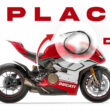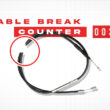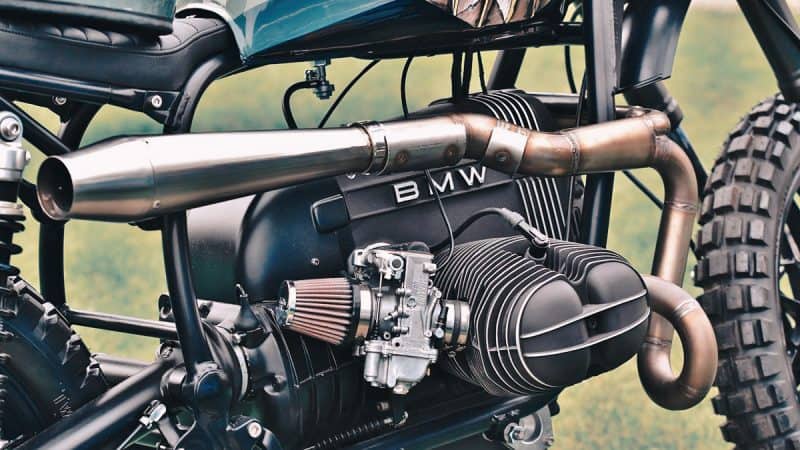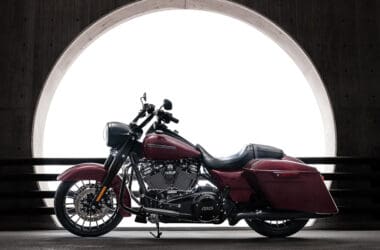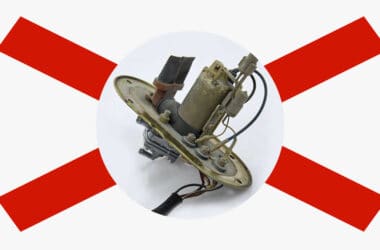Table of Contents Show
Engine heating is a problem of its own, but being unable to start your motorcycle due to engine heating is a disaster. The majority of the riders will face this problem during their long rides/trips. Many of the causes for a motorcycle engine’s hot temperature are very common.
Motorcycle won’t be able to start when the engine is hot due to the following major reasons, bad starter, defective ECU ( Engine Control Unit), faulty fuel pump, faulty spark plug, defective temperature sensor, bad main relay, fuel vapor lock. Be sure to check the component’s connection to the ECU.
Be sure to check all the components before replacing them. Sometimes it’s just might be a loose connection of the components ( i.e spark plugs, starter, temperature sensor, etc ). One has to check all the components before replacing them. Sometimes it just might be a loose connection of the components to the engine control unit.
Reasons Why Motorcycle Won’t Start When The Engine Is Hot
As you know ECU ( Engine Control Unit ) is considered as the brain of the motorcycle and engine as a heart. Both of them should work concurrently in flawless condition. So when the engine gets hot some of the following things you should take into consideration, which might be causing your motorcycle to not start.
Note: Be sure to check for any loose or cut-off connection of the components to the ECU.
So here are reasons why a motorcycle won’t start when the engine is hot.
1. Defective Coolant Temperature Sensor
The ECU ( Engine Control Unit ) considers the engine is cold if the coolant temperature is defective, this might spray more fuel than necessary for ignition.
This defect might also lead to a variety of problems such as hard start, no start condition, it might run rough or stall completely. Repairing or replacing a defective coolant temperature sensor will do the job.
2. Check For Any Faulty Spark Plugs
The function of the spark plug is to produce the spark and start the combustion. Electric energy is transmitted through a spark plug.
If the spark doesn’t ignite, then the engine won’t be able to start. Clean the spark plugs and try again. If the problem persists replace the spark plugs.
3. Defective ECU ( Engine control unit ) Can Also Contribute
ECU ( Engine Control Unit ) is the brain of a motorcycle. It does all the computing work. It detects the gear position, crankshaft position, camshaft position, coolant temperature, air density sensor.
The prime task of ECU is to control the air-fuel mixture. In some motorcycles, ECU is placed above the engine, which is a bad design in itself.
Because once the engine gets heated up the ECU will be susceptible to high temperature, which is not an optimal condition for ECU to function. The engine control unit can only work under some specific temperature as designed by the OEM ( Original Equipment Manufacturer ).
Even the cracked soldering joints might cause that issue, as the cracks will cause an open circuit which will stop the flow of current. Hence the engine won’t crank.
4. Bad Motorcycle Starter Motor
The fundamental task of a motorcycle starter solenoid is to start the engine. When the starter button is pressed electric impulse flows from the starter motor to the starter solenoid, then the current passes from the coil through the solenoid.
Then the plunger is pushed in the forward position. Once the pinion ( round gear ) starts rotating, the flywheel will also start to rotate. As both are attached.
Since the flywheel is attached to the crankshaft, even the crankshaft will start to rotate. Crank is attached to the piston through the connecting rod. As a result of all the following actions, the engine starts working. If the starter motor is not in motion, then the engine won’t crank.
And it all starts with the electric impulse, which flows from the starter motor to the starter solenoid. If there is a defect or disconnect in this particular action, the engine won’t be able to carry on the proceeding actions for the motorcycle to start.
5. Faulty Fuel Pump Working Under Low Pressure
The fundamental task of the fuel pump is to transfer fuel from the fuel tank to the fuel injector. Usually, the fuel is transferred under high pressure to the injector. But in some cases, it is transferred under low pressure, which is not optimal.
The fuel pump operates under a specific temperature. If the temperature exceeds, then the fuel pump may malfunction and cause insufficient fuel supply causing the motorcycle to eventually stall and not start.
If you have a faulty or damaged fuel pump, change it as soon as possible.
6. Main Relay Exposed To High Temperature
The basic function of the main relay is to provide optimum power to the ECU so that it can run and function as intended.
If it is exposed to high heat it can be damaged over time. It gets damaged as the soldering joint on the circuit board starts to crack and cause an open circuit. Resoldering the circuit board can solve the problem.
5. Fuel Vapor Lock Caused By Hot Weather Or High Temperatures
This might happen due to the hot weather or extremely hot surroundings.
The fuel in the tank evaporates, thus the fuel’s liquid state is converted into the vapor/gas state. This condition results in hard cranking/start or no start condition. In most cases repairing fuel vapor lock will do the job.
7. Defective Radiator Or Radiator Thermostat
The thermostat sends information about engine temperature to ECU ( Engine Control Unit ) about engine temperature, then turns on the radiator fan if necessary.
If the temperature sensor ( Thermostat ) fails to send a signal, then the coolant in the motorcycle won’t cool down. And will keep circulating between radiator fins and the engine in a not so optimal state, resulting in inefficient engine cooling.
8. Resistance To Motorcycle’s Engine
If the wheel bearing grease is not sufficient or if the wheel bearings, drum brakes, disc brakes are jammed the engine has to overcome the extra resistance.
Thus the engine has to keep up high rpm than necessary, resulting in overheating the engine.
9. Unnecessary Overloading Of The Motorcycle
When the motorcycle has more load than naturally. The engine has to pull more load, check out the user manual for the load capacity of your motorcycle when going on a long trip.
Carry the essentials and other gear while staying within load capacity.
10. Not Tuning The Carburetor When Upgraded
When the air filter or the exhaust is modified, then the carburetor should be re-tuned.
Stock carburetors are tuned according to the stock air filter and exhaust. So be sure to re-tune your carburetor.
What Are The Causes For High Engine Temperature
The foremost reason for high engine temperature is because of inefficient ventilation, lean mixture, constant high rpm, or lower engine oil level.
The air filter and radiator should not be clogged as the air flows through them, keeping them clean will do wonders to the motorcycle. Check for any coolant leaks and also the coolant levels.
There are threes types of motorcycles available in the market air-cooled, oil-cooled, and liquid-cooled. The cooling of an air-cooled engine is much more complex as there are too many components involved.
In an oil-cooled engine, coolant and radiator are added components. whereas in oil-cooled engine heat passes through a heat exchanger, typically a type of radiator known as an oil cooler. And for an air-cooled engine, there is no need for a radiator.
- The air-cooled engine is simple in design and the cooling is done with the help of fins and the entire cooling is dependent on the atmospheric air.
- In the oiled cooled engine, cooling is done with the help of air-fins and engine oil. Since engine oils get too hot, there is an oil cooler attached which looks like a radiator. Oil cooler(with capillary tubes and metal fins) cools down the engine oil temperature.
- In a liquid-cooled engine, the cooling capacity is more than its counterparts. The cooling is done with the help of a coolant with anti-freezing and anti-corrosion additives. Water jets are used in cylinder heads and blocks, coolant is passed through those water jackets. A radiator is used in this engine to cool the coolant which is placed in front of the engine.
You should know that the cooling of each kind of motorcycle is different.
Air-cooled engines depend on the fins and atmosphere air completely for cooling purposes. It has many restrictions when it comes to aggressive riding as an air-cooled engine cannot keep a high engine RPM for a longer duration of time.
When it comes to the oil-cooled engine, cooling is done with the help of engine oil as well as air fins. So keeping proper engine oils level is a must as the cooling of the entire engine depends on it.
In a liquid-cooled engine, cooling is dependent on engine oil as well as a coolant. The cooling is much more efficient in liquid-cooled engines, and the engine can take on high rpm for a longer time.
Motoxtasy Tip: A motorcycle with a carburated engine needs to be tuned according to the lean mixture or rich mixture. An optimum mixture is recommended ( i.e. in between lean and rich mixture ). Maintaining an appropriate air-fuel mixture is an important factor when it comes to overheating engines.
Tips To Avoid High Engine Temperature
Many factors result in higher engine temperature. But here are a few tips to look out for if you want to avoid the high engine temperature of your motorcycle.
- Maintaining engine oil and coolant levels as recommended and changing them from time to time. When the engine oil or coolant gets outdated it loses its effectiveness, and the liquid tends to loosen up its chemical bonding over time.
- Avoid continuous high RPM( revolution per minute ) and hard engine braking, which will result in high engine temperature. When the engine is revved at higher rpm for a longer duration there is inefficient cooling as the speed of the engine is too high.
- Avoid any resistance to the motorcycle due to jammed brakes or wheel bearings.
- Overloading the motorcycle will also result in high engine temperature as the engine has to put extra effort to overcome it.
- Turn off the ignition of your motorcycle if you are stuck in heavy traffic. Because motorcycles in the stationary state will have low to no airflow to the engine. Due to this, the motorcycle produces a rich mixture which will result in higher engine temperature.
How To Start Your Motorcycle In This Situation
In this situation just let the motorcycle cool itself, don’t throw or spray water as it leads to internal microscopic cracks.
It’s not rocket science guys, just let the motorcycle take a breather and let it cool down for 30 minutes to 1 hour and try to start again. And most likely you will face this problem while being on a long trip
Conclusion
So if the motorcycle is not starting in this kind of situation, first let the motorcycle cool off. Check for any defects in your ECU ( Engine Control Unit ) and other components which are connected to it.
If you are unable to fix it by yourself, go to the mechanic to save the hassle. And if your motorcycle has a carbureted engine, make sure to tune it according to the fuel mixture you are running. Follow the steps and reasons mentioned in this article to find and solve this problem.
And if your motorcycle is acting like an A-hole, do what every man and woman has to do ( Give It Up For Adoption ) or probably don’t do it or you will have to live the rest of your life with guilt and shame. As a fellow rider and from one rider to another, ENJOY YOUR MOTORCYCLE LIKE YOU ENJOY YOUR………

